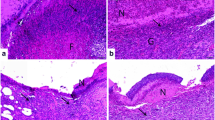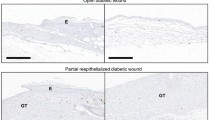Abstract
Impaired angiogenesis is a common pathological characteristic of chronic wounds. Therefore, the regulation of angiogenesis is important for proper tissue repair. It was reported that substance P (SP) accelerates wound healing in a skin injury model. SP is degraded by neutral endopeptidase (NEP). Our study shows that systemic co-treatment of SP and thiorphan, an inhibitor of NEP synergically increased the number of α-smooth muscle actin positive-blood vessels in skin wounds. However, there was no synergic improvement in wound contraction and extracellular matrix deposition. Therefore, inhibition of endogenous NEP activity by thiorphan treatment might modulate the effects of SP treatment specifically on accelerating angiogenesis during wound healing. However, the molecular mechanism(s) of the synergic increase in angiogenesis by SP and thiorphan treatment is still unknown.
Similar content being viewed by others
References
Dubon MJ, Park KS. Substance P enhances the proliferation and migration potential of murine bone marrow-derived mesenchymal stem cell-like cell lines. Exp Ther Med 2015;9:1185–1191.
Hong HS, Lee J, Lee E, Kwon YS, Lee E, Ahn W, et al. A new role of substance P as an injury-inducible messenger for mobilization of CD29(+) stromal-like cells. Nat Med 2009;15:425–435.
Yang L, Di G, Qi X, Qu M, Wang Y, Duan H, et al. Substance P promotes diabetic corneal epithelial wound healing through molecular mechanisms mediated via the neurokinin-1 receptor. Diabetes 2014;63:4262–4274.
Kant V, Gopal A, Kumar D, Bag S, Kurade NP, Kumar A, et al. Topically applied substance P enhanced healing of open excision wound in rats. Eur J Pharmacol 2013;715:345–353.
Roques BP, Noble F, Daugé V, Fournié-Zaluski MC, Beaumont A. Neutral endopeptidase 24.11: structure, inhibition, and experimental and clinical pharmacology. Pharmacol Rev 1993;45:87–146.
Olerud JE, Usui ML, Seckin D, Chiu DS, Haycox CL, Song IS, et al. Neutral endopeptidase expression and distribution in human skin and wounds. J Invest Dermatol 1999;112:873–881.
Kletsas D, Caselgrandi E, Barbieri D, Stathakos D, Franceschi C, Ottaviani E. Neutral endopeptidase-24.11 (NEP) activity in human fibroblasts during development and ageing. Mech Ageing Dev 1998;102:15–23.
Indig FE, Benayahu D, Fried A, Wientroub S, Blumberg S. Neutral endopeptidase (EC 3.4.24.11) is highly expressed on osteoblastic cells and other marrow stromal cell types. Biochem Biophys Res Commun 1990;172:620–626.
Rasini V, Dominici M, Kluba T, Siegel G, Lusenti G, Northoff H, et al. Mesenchymal stromal/stem cells markers in the human bone marrow. Cytotherapy 2013;15:292–306.
Kohn LA, Hao QL, Sasidharan R, Parekh C, Ge S, Zhu Y, et al. Lymphoid priming in human bone marrow begins before expression of CD10 with upregulation of L-selectin. Nat Immunol 2012;13:963–971.
Jang TJ, Park JB, Lee JI. The expression of CD10 and CD15 is progressively increased during colorectal cancer development. Korean J Pathol 2013; 47: 340–347.
Goodman OB Jr, Febbraio M, Simantov R, Zheng R, Shen R, Silverstein RL, et al. Neprilysin inhibits angiogenesis via proteolysis of fibroblast growth factor-2. J Biol Chem 2006;281:33597–33605.
Horiguchi A, Chen DY, Goodman OB Jr, Zheng R, Shen R, Guan H, et al. Neutral endopeptidase inhibits prostate cancer tumorigenesis by reducing FGF-2-mediated angiogenesis. Prostate Cancer Prostatic Dis 2008;11:79–87.
Davies KP, Tar M, Rougeot C, Melman A. Sialorphin (the mature peptide product of Vcsa1) relaxes corporal smooth muscle tissue and increases erectile function in the ageing rat. BJU Int 2007;99:431–435.
Koh YH, Moochhala S, Bhatia M. The role of neutral endopeptidase in caerulein-induced acute pancreatitis. J Immunol 2011;187:5429–5439.
Antezana M, Sullivan SR, Usui M, Gibran N, Spenny M, Larsen J, et al. Neutral endopeptidase activity is increased in the skin of subjects with diabetic ulcers. J Invest Dermatol 2002;119:1400–1404.
Matsas R, Kenny AJ, Turner AJ. The metabolism of neuropeptides. The hydrolysis of peptides, including enkephalins, tachykinins and their analogues, by endopeptidase-24.11. Biochem J 1984;223:433–440.
Medja F, Lelièvre V, Fontaine RH, Lebas F, Leroux P, Ouimet T, et al. Thiorphan, a neutral endopeptidase inhibitor used for diarrhoea, is neuroprotective in newborn mice. Brain 2006;129(Pt 12):3209–3223.
Werner S, Grose R. Regulation of wound healing by growth factors and cytokines. Physiol Rev 2003;83:835–870.
Robins SP, Milne G, Duncan A, Davies C, Butt R, Greiling D, et al. Increased skin collagen extractability and proportions of collagen type III are not normalized after 6 months healing of human excisional wounds. J Invest Dermatol 2003;121:267–272.
Tonnesen MG, Feng X, Clark RA. Angiogenesis in wound healing. J Investig Dermatol Symp Proc 2000;5:40–46.
Mitra R, Chao OS, Nanus DM, Goodman OB Jr. Negative regulation of NEP expression by hypoxia. Prostate 2013;73:706–714.
Park PJ, Lee TR, Cho EG. Substance P stimulates endothelin 1 secretion via endothelin-converting enzyme 1 and promotes melanogenesis in human melanocytes. J Invest Dermatol 2015;135:551–559.
Author information
Authors and Affiliations
Corresponding author
Rights and permissions
About this article
Cite this article
Um, J., Yu, J., Dubon, M.J. et al. Substance P and thiorphan synergically enhance angiogenesis in wound healing. Tissue Eng Regen Med 13, 149–154 (2016). https://doi.org/10.1007/s13770-016-9089-y
Received:
Revised:
Accepted:
Published:
Issue Date:
DOI: https://doi.org/10.1007/s13770-016-9089-y




